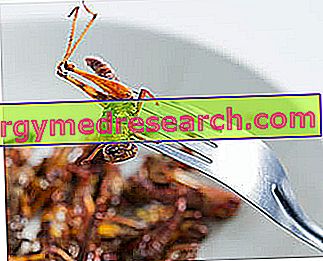Introduction
In certain areas of the planet, insects represent a widely consumed food, so much so that they have aroused some interest from large food production companies. In the article that follows, we will try to better understand what insects, who feeds them and why they could represent the human food fulcrum for the new millennium.

What are Insects?
The term "insects" means a class ( Insecta ) of creatures belonging to the animal kingdom (Animalia L., 1758).
In common language and imagination, all invertebrate creatures with legs (Phylum Arthropoda) are considered insects; however, the scientific classification is much more articulated, as it provides an initial subdivision for: domain, Kingdom, Sub-Greco, Branch, Phylum, Subphylum and Superclass. In addition to the special class, insects should also be distinguished by: subclass, cohort, superorder, etc., up to genus and species.
It must therefore be considered that not all small animals, provided with so many legs, perhaps with wings and with a more or less revolting aspect, can be considered insects. For example, spiders and scorpions, while strongly resembling the category in question, belong to the class of Arachnids ( Arachnida ); this does not mean that, in certain cultures, even these invertebrate animals (as well as worms and insects) represent a source of food sustenance far from negligible.
Insects in Western Culture
It is likely that most readers are facing this reading out of curiosity, perhaps aroused by a pinch of annoyance, or by a real abhor (based on subjectivity); after all, for humans, insects represent a source of wealth (pollination of flowers in agriculture, production of honey, etc.), as well as a source of discomfort (poisonous or annoying bites, such as mosquitoes, bees, or wasps, hornets, bed bugs, fleas, ticks, etc. which represent a source of infectious contagion, poisoning or allergic reaction).
On the other hand, in the hope of offering an alternative point of view, it is my intention to point out the close resemblance of the very precious crustaceans with the invertebrates taken into consideration. I challenge anyone to deny that a spider crab represents the alter ego of a spider, a sea cicada of a huge cockroach and a mantle of a praying mantis. " And if even the insects were so tasty? "
By the way, many consumers do not even suspect that certain insects are already part of the Western diet. This is the case of red cochineals (Genus Cocci, Specie cacti ), from which (by grinding them) the food industry produces the additive E120 or “cocciniglia red”. This dye is aimed at the pigmentation of industrial processing foods, such as chocolate lenses, certain candies, some drinks, etc.
Now, let's try to understand what could be the advantages or disadvantages of inserting insects (and also other creatures usually considered as such) in the customary diet.
Insects at the Table: Why?
For some years now, the food industries have been concentrated in the search for alternative sources of high biological value (VB) proteins or characterized by an amino acid profile such as to be able to compensate that of low-cost and wide consumption foods (eg wheat or rice or corn).
The most innovative products are soy (and other legumes), algae, canola, some pseudo-cereals (amaranth, quinoa, etc.) and insects.
To date, there are already real companies that deal with production, wholesale and food use of insects for humans. Of course, in the East, where insects make up a large part of the customary diet, the sale of these small creatures "in box" or "in envelope" would not be so strange. However, recently, this sector has also found considerable interest on the American continent, where certain products are spreading like wildfire.
Proteins are not the only nutrient present in abundance in the meat (so to speak) of our small and unpleasant friends. Certain mineral salts and some vitamins seem to abound, in concentrations such as to put a strain on the comparison with most of the products mentioned in the food composition tables.
It is therefore conceivable that, although edible insects currently represent a novelty, in the future they could represent an ordinary or even traditional food even for the West.
To read more about this topic, we recommend reading the article: Farina di Grillo.
Insects in Traditional Food
The food consumption of insects, or entomophagy, represents an extremely widespread habit in various parts of the world. It is particularly common in the Asian continent, in central-southern America and in Africa, where insects, arachnids and larvae constitute a veritable gluttony for indigenous peoples.
Taken from the site ilturista.info, below we will make a brief summary of the most consumed invertebrates and the relative place or people who use them.
- Red weevil larvae: they are the non-evolved form of an insect, also known in Italy for its ability to destroy palms. They are eaten roasted or fried, especially in New Guinea and Malaysia.
- Ants and Ant Eggs: honeypots are ants capable of collecting nectar in the posterior portion of the abdominal region (see also: Insect abdomen: is it different?) And eat raw as a dessert. Colombian ants, on the other hand, lend themselves to being toasted, while in Thailand these insects and their eggs are cooked in a pan. In Mexico, ant eggs (found mainly during the agave harvest) are boiled and sautéed with butter or used for tacos filling. The countries that use ants for food are Australia, Colombia, Thailand and Mexico.
- Bedbugs: in Mexico they are purged in warm water to eliminate the smell, while in Africa, after beheading and pressing, they are boiled and dried. The places where the bugs are consumed are Mexico and South Africa.
- Tarantulas: they are fried and caramelized or roasted. They are consumed in Cambodia and Venezuela.
- Termites: they are eaten raw, roasted on the grill and fried. They are mainly found in West Africa, Australia and in some areas of South America
- Huhu grubs larvae: they are of considerable size; in New Zealand they are mostly consumed sautéed.
- Larvae of Vespa or Hachinoko: in Japan they are eaten cooked in soy sauce and sugar, sometimes enriched with a handful of sauteed and crunchy wasps.
From what we have read so far, it is possible to infer that the populations of as many as four "half" continents out of seven (Asia, Oceania, Africa, South America and Central America) use insects in human nutrition. Only Europe, North America and Antarctica are excluded.
In spite of what we Westerners could perceive, it is not strange to consume insects, but to exclude them from the diet by plotting generational of our "gastronomic whim".



